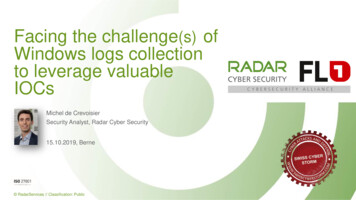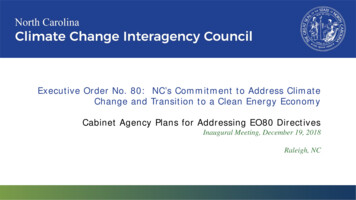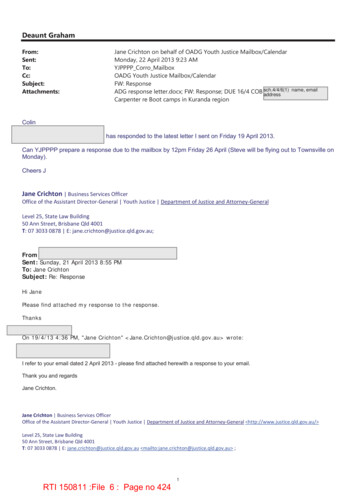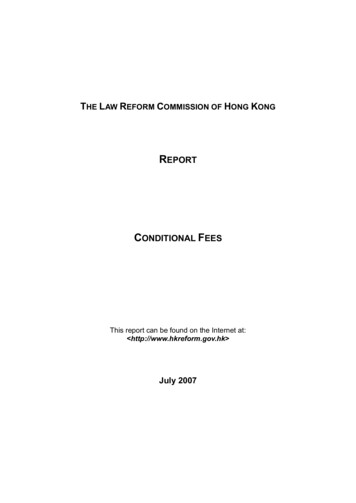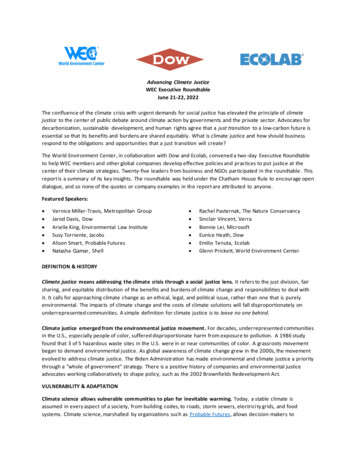
Transcription
Advancing Climate JusticeWEC Executive RoundtableJune 21-22, 2022The confluence of the climate crisis with urgent demands for social justice has elevated the principle of climatejustice to the center of public debate around climate action by governments and the private sector. Advocates fordecarbonization, sustainable development, and human rights agree that a just transition to a low-carbon future isessential so that its benefits and burdens are shared equitably. What is climate justice and how should businessrespond to the obligations and opportunities that a just transition will create?The World Environment Center, in collaboration with Dow and Ecolab, convened a two -day Executive Roundtableto help WEC members and other global companies develop effective policies and practices to put justice at thecenter of their climate strategies. Twenty-five leaders from business and NGOs participated in the roundtable . Thisreport is a summary of its key insights. The roundtable was held under the Chatham House Rule to encourage opendialogue, and so none of the quotes or company examples in the report are attributed to anyone.Featured Speakers: Vernice Miller-Travis, Metropolitan GroupJarod Davis, DowArielle King, Environmental Law InstituteSusy Torriente, JacobsAlison Smart, Probable FuturesNatasha Qamar, Shell Rachel Pasternak, The Nature ConservancySinclair Vincent, VerraBonnie Lei, MicrosoftEunice Heath, DowEmilio Tenuta, EcolabGlenn Prickett, World Environment CenterDEFINITION & HISTORYClimate justice means addressing the climate crisis through a social justice lens. It refers to the just division, fairsharing, and equitable distribution of the benefits and burdens of climate change and responsibilities to deal withit. It calls for approaching climate change as an ethical, legal, and political issue, rather than one that is purelyenvironmental. The impacts of climate change and the costs of climate solutions will fall disproportionately onunderrepresented communities. A simple definition for climate justice is to leave no one behind.Climate justice emerged from the environmental justice movement. For decades, underrepresented communitiesin the U.S., especially people of color, suffered disproportionate harm from exposure to pollution. A 1986 studyfound that 3 of 5 hazardous waste sites in the U.S. were in or near communities of color. A grassroots movementbegan to demand environmental justice. As global awareness of climate change grew in the 2000s, the movementevolved to address climate justice. The Biden Administration has made environmental and climate justice a prioritythrough a “whole of government” strategy. There is a positive history of companies and environmental justiceadvocates working collaboratively to shape policy, such as the 2002 Brownfields Redevelopment Act.VULNERABILITY & ADAPTATIONClimate science allows vulnerable communities to plan for inevitable warming. Today, a stable climate isassumed in every aspect of a society, from building codes, to roads, storm sewers, electricity grids, and foodsystems. Climate science, marshalled by organizations such as Probable Futures, allows decision-makers to
2visualize the impacts of climate change on individual communities and “peel away the onion” to figure out whereclimate stability has been assumed and where resilience needs to be built. The Southeast Florida Climate Compactwas cited as a good example of regional planning and action for climate adaptation, including involvement ofbusiness leaders who were motivated by a regional study on the business case for resilience. It’s important forcommunities to have freely available information, tools, and technical education so that they aren’t in the darkabout climate impacts and can advocate for themselves in decisions that impact them. Still, it’s a delicate balancebetween informed dialogue and empowering decisions at the community level. Some technical decisions aboutpublic infrastructure need to be based on science, and “engineering shouldn’t happen on the dais.”Underrepresented communities are especially vulnerable to climate change. In the U.S., African American andHispanic neighborhoods are historically overburdened by pollution and more vulnerable to the health impacts ofextreme heat. They also tend to be in low-lying areas more prone to flooding. In the words of one roundtableparticipant, “no one chooses to live next to stuff that poisons them—half the time they don’t know that choice hasbeen made.” Cumulative impact is a key concept: communities that face public health inequities also suffer frompolice brutality, food deserts, and other stressors. Effective strategies for climate adaptation must addresssystemic threats in a holistic way, not only the direct, physical impacts of climate change. Underrepresentedcommunities have less power in public decision-making processes than those that are politically well connected. Inthe words of another participant, “there are always winners and losers, but we keep picking the same losers.”Speakers recommended centering adaptation strategies on those most harmed by climate change. Col laborativeproblem solving with affected communities is essential and more effective than imposed solutions.Resilience Hubs are a promising approach. Climate adaptation plans need to focus on people, not just policiesand infrastructure. Florida’s Miami Dade County is developing a network of resilience hubs, hyperlocal institutionsthat will serve as emergency operations centers during climate disasters. The idea was pioneered during 2017’sHurricane Irma by an NGO which disseminated information to the c ommunity through a trusted activist’s socialmedia and provided a place for people to gather and get essential supplies. A county-wide project team isconducting a vulnerability assessment to determine where to site new hubs and how they will operate andconnect. Plans will be determined by the communities themselves, and each hub will have its own governancemodel. A guide will be created for replication elsewhere.Water risk connects companies and communities in vulnerability & adaptation. According to S&P Global, the topclimate risk that companies face is water stress. Leading companies are pursuing nature -based solutions in keywatersheds to increase water supply and access, improve water quality, and conserve biodiversity. These actionslook beyond individual sites and move a company to adapt and prepare at a larger scale. Because water ismanaged in a system, including upstream and downstream users, corporate water management needs to be acommunity conversation, not managed in a silo of “just my organization.” Water management provides a goodplatform for collaboration with local communities on climate vulnerability and adaptation.JUST TRANSITIONClimate justice requires a just transition to a net zero economy. Avoiding climate catastrophe demandsfundamental changes in the world’s energy, transportation, and agricultural systems. There will be winners andlosers in this transition. Without safeguards, indigenous, minority, low-income, and other underrepresentedcommunities will be on the losing side. One company defines just transition this way: “to sustain progress inreducing emissions, the economic, social, and environmental benefits must be felt by all. A just transition is howwe manage societal impacts successfully.” Roundtable participants identified three areas of focus for a justtransition: (1) providing new employment opportunities; (2) helping resource -dependent communities diversifytheir economies; and (3) ensuring equitable access to clean energy.All industries need to think about the future of their workforces. Every part of the workforce that will becomesmaller as the economy decarbonizes needs a transition plan. A just transition requires a plan for workforce
3development and job opportunities at the prevailing wage or better that maintain quality of life. Companies mustengage on the topic with labor unions, local governments, and other stakeholders and reorient their talentpipelines to fill the jobs required in a net-zero economy. Several participants are collecting data within theirbusinesses on new job requirements and linking with their companies’ DEI initiatives. Partnerships withuniversities need updating, as most academic institutions aren’t preparing their students for the jobs of the futureand enrollment in sustainability programs is not diverse. Participants agreed that workforce development is astrategic constraint and recommended a collaborative effort across industries to address it.Companies need to provide for workers and communities when exiting high-carbon businesses and enteringlow-carbon ones. In addition to direct employment, energy, mining and industrial projects drive local economiesand government budgets. Communities need to be at center of decision-making when assets are shut down or soldto new owners, who may not share a departing company’s values or capacity for engagement. The same goes fordevelopment of new, low-carbon assets, to ensure local participation in assessment and decision-making on aproject’s economic, social, and environmental impacts. One company establishes community advisory panels at itssites with a cross-section of community groups to provide two-way interaction on needs, issues, and concerns.When an asset is sold, the company brings the purchasing entity into the advisory panel to encourage continu ity.Companies typically make exit plans when they develop a new asset, including provisions for ongoing benefits tothe community—however these are often decades old and should be reviewed and updated as companies prepareto exit high-carbon assets. When developing new clean energy projects, such as offshore wind or remote solar,definitions of "community” and “fence line” aren’t as clear. One participant noted that EPA’s environmental justicescreening tools don’t provide sufficient guidance on the topic. BSR and the B Team have created the coalitionEnergy for Just Transition to create guiding principles for the energy sector. Other industries also require attention.Shipping, for example, needs to engage traditional maritime communities to ensure that they are not left behindas the industry transitions to new fuels. Local governments will play a key role.Just transition also means providing equitable access to clean energy. As economies transition from fossil fuels tocarbon-free energy, will low-income people be able to afford it? Energy companies need to work with regulators todrive economies of scale to make clean energy affordable. One energy company’s theme is “everyone forward:”how to help everyone along the energy transition journey and not leave anyone behind. Even with such a goodintention, most large energy companies aren’t responsible for consumer access and may want to considerinnovative business models to reach low-income communities with clean energy.CARBON MARKETSCarbon markets create unique climate justice concerns. Voluntary and regulated carbon markets have movedhundreds of millions of dollars into a wide range of climate solutions, from forest carbon to energy efficiency.Trading emissions between one location and another can keep overall abatement costs down, and many offsetshelp to reduce poverty and empower indigenous and low-income communities. Still, offsets may not reduceoverall emissions and they can exacerbate pollution impacts on communities that bear the emissions while fundingflows to people in other places.Carbon market actors should apply the mitigation hierarchy. First, avoid activities that produce emissions. Next,reduce emissions as much as possible. Finally, offset only residual emissions. Buying credits first won’t solve theclimate problem and ignores pollution at origin. Focus credit purchases first on reducing emissions in your ownvalue chain (known as insetting). Link any credits to a verifiable claim rooted in the mitigation hierarchy. Betransparent about what you are doing in your value chain.Buyers of carbon credits should focus on high-quality emissions reductions. A suite of independent standards canensure that carbon offset projects provide real, permanent, and additional climate benefits. The Verified CarbonStandard (VCS) covers 80 percent of credits in the voluntary market and requires that a project contr ibute to atleast three of the SDGs. The Climate, Community & Biodiversity (CCB) Standards and the Sustainable Development
4Verified Impact Standard (SDVISTA) verify that a project provides measurable co-benefits beyond carbon. Speakerswere confident that application of these and other standards in the voluntary market will move projects toward a“net positive impact” for sustainable development. Projects with co-benefits verified by CCB and SDVSTA arebeginning to command a price premium in the voluntary market.Initiatives are underway to ensure integrity in companies’ net-zero claims. The Integrity Council for VoluntaryCarbon Markets (ICVCM) is working to define what a quality carbon credit is and set criteria for voluntarystandards, such as VCS and the Gold Standard. The ICVCM will release initial standards in the fall of 2022. TheVoluntary Carbon Markets Initiative will set standards for a company’s net-zero commitments and claims. It iscurrently vetting a Claims Code of Commitments with stakeholders.Natural climate solutions (NCS) can benefit indigenous and traditional communities. Conserving forests andother ecosystems can provide 30 percent of emissions reductions needed through 2030 to keep climate changebelow 2 degrees. Traditional knowledge is being incorporated in conservation science and providing the basis forlarge scale NCS that empowers indigenous communities. In Australia, Aboriginal communities generated 25million in verified carbon credits from the traditional practice of using fire in cool seasons to avoid hotter fires insummer. Large scale, community based NCS programs are underway in India and East Africa.Carbon markets alone won’t be sufficient to scale NCS. The IPCC estimates that 400 billion will be neededannually to implement cost effective NCS in forests alone. Carbon markets, expected to reach 4 billion, will be adrop in the bucket. NGOs are working to identify new revenue sources for NCS, includin g redeployment of existinggovernment budgets—a promising effort is underway in India that could generate 40 billion for forestconservation. Companies should explore innovative ways to finance NCS beyond buying carbon credits. Suchinvestments need to apply the same quality standards to ensure climate, human rights, and biodiversity protectionand capacity must be built in community organizations to implement NCS effectively at scale.STRATEGIES FOR ACTIONThe U.S. federal government is starting to act, but states are leading the way. President Biden issued executiveorders on his first day in office addressing environmental justice and systemic racism. In response, agencies anddepartments across the federal government are creating their own EJ office s and initiatives. The Justice40 initiativepromises to deliver 40 percent of federal investments in climate and clean energy to disadvantaged communities.EPA has released a suite of analytical tools to integrate environmental justice in decision -making, includingEJScreen, the Climate & Economic Justice Screening Tool, and the ECHO database. While EPA’s tools aren’tprescriptive, at least 17 states have developed their own EJ tools and some states are basing permitting decisionson the use of these tools and mandating a higher level of accountability for the private sector. In New Jersey, apermit must be denied if there is a showing of contribution to harm in an already disadvantaged community.California, Michigan, and Pennsylvania are also developing EJ rules that can affect license to operate. Participantsnoted that regulations in just a few large states could become de -facto national standards, citing the examples offuel-economy rules in California and text book standards in Texas.Leading companies are developing corporate strategies to advance climate and environmental justice. In theU.S., the murder of George Floyd was a catalyst for the convergence of the social justice and sustainabili tymovements. Groups that operated in silos came together under an umbrella of social justice. The businesscommunity needs to recognize this and address sustainability from a social justice perspective . Companies withstrong core values see climate justice as a public obligation. One participating company has initiated an externalracial equity audit, in which an independent third party will look at the company’s policies and procedures for itsoperations and products, note areas of strength, and make recommendations for improvement. Another companyhas created a full-time position of Head of Environmental Justice. This company had just set ambitioussustainability goals and realized that “if you don’t build equity and justice into your sustainability p rograms, youwill achieve sustainability at scale in an unjust and inequitable way.” Climate justice is fundamentally linked to a
5company’s ESG performance, which now impacts access to capital, corporate reputation, and license to operate .In the words of another participant, “it’s about the marriage of social justice and environmental protection.”Climate justice and social justice don’t translate the same in all countries. Companies can have global principles,but strategic goals and implementation strategies must be tailored to a country’s unique circumstances. Severalparticipants are starting in the U.S., where the environmental and climate justice movements are more mature.Companies are starting internally to develop climate justice strategies before engaging externally. Oneparticipant is developing their strategy in the U.S. in four phases: (1) initial qualitive assessment of key sites basedon internal expertise; (2) quantitative assessment of those sites using EPA and state EJ tools (see above ); (3) publicconsultations in those communities about the company’s performance and the community’s needs; and (4)creation of an action plan. Another company formed a Just Transition Working Group across functions andbusinesses that will set global strategy and allow flexibility for country business units to address realities in theirmarkets. One participant cautioned against thinking of EJ as a separate program. Instead, build justice and equityconsiderations throughout the business—like sustainability in the first place.Climate justice is not entirely new. One company had already set goals around “community success” in 2015. Theyare building on their record of social performance and not introducing concepts of environmental and climatejustice in a formulaic way. Another company is connecting to existing racial equity initiatives and DEI principles inrecruiting and supply chain. “Elevating pieces that are already moving makes it feel less scary than suggesting acompletely new thing.”A company’s most powerful ambassadors to communities are its employees. Employees who volunteer incommunities build credibility and trust so that the company, “doesn’t just show up when it’s time for permitrenewal.” Many employees don’t realize how relevant their job is: “for every operator working on the midnightshift, the work you are doing to minimize emissions is driving the EJ strategy for the company.” Engagingemployees “can take a concept that’s very broad down to what employees can do right now.” Think about apyramid, both top-down mandates and bottom-up mobilization, and “work a different part of that pyramid everyday; enable the organization with the full force of what you already have in the culture of your organization.”Companies are supporting actors. Companies need to learn from and build partnerships with community leaders.Speed is not always the right answer. Companies need to commit for the long term, and results will take longerthan they expect. They need to earn the trust of community leaders, allow their voices to be heard, and recognizethose leaders’ decision-making power in their communities. The people a company perceives to be communityleaders may not be the people the community considers their leaders. It’s important to set ground rules to beinclusive; the Jemez Principles are a good model.If you don’t embed equity, you will produce inequality. Several participants shared efforts to embed justice andequity principles into their companies’ climate innovation funds and technology accelerators. They are working toensure that the interests of low income and vulnerable communities are considered in the selection of technologyinvestments. One has allocated a portion of its fund to invest in more diverse founders and the types of problemsthey are working on, including resilience and adaptation, which has less access to funding than mitigation.Existing policies on business and human rights provide important grounding. The UN Human Rights Councilestablished a Working Group on Business and Human Rights in 2011 and issued Guiding Principles on Business &Human Rights in 2012. States have an obligation to protect people, and corporations have a responsibility torespect people. The UN has created holistic tools for human rights impact assessments in companies’ operations,procurement, and site development. A useful way for companies to start is to embed human rights risks into theirenterprise risk management systems. The EU has proposed a Corporate Sustainability Due Diligence Directive thatwill make environmental and human rights assessments compulsory for business. This mandate will affect U.S.companies that do business with European companies.
6Addressing climate justice can be frustrating. Everyone wants to do the right thing—but companies don’t yethave the rules, tools, or metrics to implement. Frustrations often arise in community consultations becausecurrent science and regulatory schemes don’t measure or manage cumulative impacts. People are communicatingutter frustration with a regulatory framework that doesn’t address how they are living.OPPORTUNITIES FOR COLLABORATIONCollaboration among companies will be essential. In the words of one participant, “no one will be the winner orsolve EJ. We’re all operating in many of the same communities. We need to collaborate.” The following ideas forstrategic collaboration were suggested.Compile available resources. Participants suggested that WEC create a digital library of resources discussed duringthe roundtable and other work on climate justice. WEC will create a new digital Climate Justice Toolbox and shareit with participants in the roundtable.Develop metrics. Safety was cited as a good example of a successful change in corporate DNA across manyindustries. How can the same kind of shift happen for climate justice? The key is metrics and accountability. What’sthe climate justice equivalent of “days since last safety incident” that companies measure and post in everyfacility? WEC could convene follow-on roundtables to develop corporate metrics for climate justice.Workforce development is a shared priority. As reported above, participants agreed that reorienting talentpipelines to build a diverse workforce skilled for building a net-zero economy is a top strategic challenge. WECcould convene companies and leading universities to act on this challenge.Could there be a voluntary reporting scheme to aggregate environmental and social impact? One participantnoted that they struggle to make ESG reporting coherent. Other participants noted that the IFC is developing acumulative impact assessment methodology and that the state of New Jersey is regulating cumulative impactsusing NEPA’s EIA procedures. Participants also discussed how a community’s lived experience and traditionalknowledge should factor into impact assessments. The rise of “citizen science” has led to an increase incommunity-based research contributing to peer-reviewed literature. As a result, lived experience is beingincorporated in scientific study. Still, there is a need for data-integrity principles to guide community input toscience-based standards and regulation.A sector-by-sector approach may be appropriate. EJ looks different and leverage points differ across sectors.There may be models of sectoral change to emulate. For example, luxury brands came together to go beyond legalrequirements for their supply chains in Zero Discharge of Hazardous Chemicals. WEC could share climate justicemodels under development, facilitate self-organizing on a sector-by-sector basis, and share common principles.Build quasi-regulatory power? Business can drive systemic change in the absence of government regulation.Examples include ESG investing, supply chain codes of conduct, insurance coverage of safety risks, and the bankingindustry’s Equator Principles for project finance. Can we create leverage points in finance, insurance, or otherstrategic sectors to drive climate justice action by businesses across the board?Explain the business case and create a roadmap for action. Climate justice needs to be put through a businesslens for companies to act. CEOs need to be clear on three questions: (1) how does it align with my businessstrategy? (2) how will it impact the world? (3) What are the implications for society? These points need to beclarified for business leaders to get it. WEC can convene further executive roundtables to clarify the business casefor climate justice and develop a high-level roadmap for corporate action.The time to start was yesterday. Reducing climate change demands urgent economic transformation, but ensuringclimate justice requires time to build trust among stakeholders. Time is not on our side. Strategic collaborationamong companies on any of the ideas suggested here must start immediately.
Workforce development is a shared priority. As reported above, participants agreed that reorienting talent pipelines to build a diverse workforce skilled for building a net-zero economy is a top strategic challenge. WEC could convene companies and leading universities to act on this challenge.
